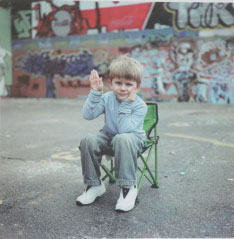But No One Ever Wants To Change© 1
No one goes willingly into an initiation. Leaving a place that is familiar and entering the unknown is upsetting and causes considerable anxiety. Think about birth. This is the first initiation and rite of passage from the womb into the world. It is almost always announced with the screams from the newborn. A harrowing experience. And, that’s not just for the newborn, but for the mother, father and family as well!
If we are truly hardwired for initiation, as some would say, documented by 40,000 years of evidence, then why does it appear to be such a difficult or confusing concept for so many? And, as a result it is not fully considered as a central element in human, organizational and community development. In 1994 I posed this question to one of my advisors, Dr. Ross Speck, the eminent psychiatrist, founder of the Family Institute of Philadelphia and first generation of the whole systems approach to psychotherapy. His interest in anthropology made him uniquely positioned to bring diverse insights from medicine and human history to bear on his thoughtful answer.
He said, “David, as you know, at the core of rites of passage and initiation is the experience of being included and excluded. Everyone has experiences where they felt included or excluded from a group. Conversations about initiation and rites of passage always stir up memories, which are usually highly charged with emotion, based on one’s past experiences. This is usually about some circumstance where they felt excluded from a group, where they did not feel affirmed, loved, or a sense of belonging. And this sense of disconnection impacted their sense of self, that is, who they are in relationship to the outside world, their community and nature. It has the potential to leave someone disconnected from their own sense of self."
The central part of any group, whether in organizations, corporations, government or a family, is the individual. Every individual shows up within these groups with their own history, ancestors, personal psychology and characteristics which inform and energize their attitudes, values and, hence, behavior. One is always in a process of initiation, becoming a member of a group, being a member of a group, or departing from the group. We are always in the ebb and flow of life as a series of beginnings, middles and endings. This living dynamic “charges” every situation with deeply felt symbols and patterns of initiation.
The familiar quote from George Santayana in The Life of Reason (1905-06) with variations credited to Winston Churchill is relevant and worth considering:
Progress, far from consisting in change, depends on retentiveness. When change is absolute there remains no being to improve and no direction is set for possible improvement: and when experience is not retained infancy is perpetual. Those who cannot remember the past are condemned to repeat it.
 An individual’s “retentiveness” helps them to become “self-aware” and is a key element in all organizations. It is not unlike the importance of “retentiveness” in the history of organizations and communities. What if an approach to community and organizational development and change incorporated design strategies that initiate - welcome and include - the psyche of the individual within the collective psyche of the organization? Might this strengthen the possibilities for collaborative, sustained action for a change?
An individual’s “retentiveness” helps them to become “self-aware” and is a key element in all organizations. It is not unlike the importance of “retentiveness” in the history of organizations and communities. What if an approach to community and organizational development and change incorporated design strategies that initiate - welcome and include - the psyche of the individual within the collective psyche of the organization? Might this strengthen the possibilities for collaborative, sustained action for a change?
Which is more important and potent to focus on in organizational and community change, the individual or the collective? It’s not an “either or”, but an “and both” proposition. An individual is a dynamic and powerful psychic entity. We are always in the process of initiation – having beginnings, middles and ending to life experiences. Organizations and communities are places where people enter, work and live and leave. One’s history with change, especially around the passage from childhood to adulthood, always impacts the rest of one’s life. Whether it is in our own personal life or our adult life within an organization or community, one’s experience with change has considerable impact.
If we do not remember our past, as it relates to change, we “are condemned to repeat it,” in ways that impact their present situation. “When experience is not retained, infancy is perpetual.”
This is one reason why initiatives with youth and community development through rites of passage include guiding principles for accommodating individual and group change. The next blog will feature some of these guiding principles, which are related to the 20 elements in the architectural structure for youth and community development through rites of passage.
Please share your thoughts, comments and questions at thecenter@rope.org.
______________________________________
♥ Fraçois de la Rochefoucauld (1613-1680) French classical author.
1 © David G. Blumenkrantz – The Center for the Advancement of Youth, Family & Community Services, Inc.
© Photos copyrighted by Iva Peele, 2013
Please enter your name and email address to receive notices of blog posts, events, and other news. * indicates required.
It’t time for a Paradigm Shift – a fundamental change in beliefs, theory and approach – in developing community-centered responses to the challenges faced by today’s Youth & Community. More here>>